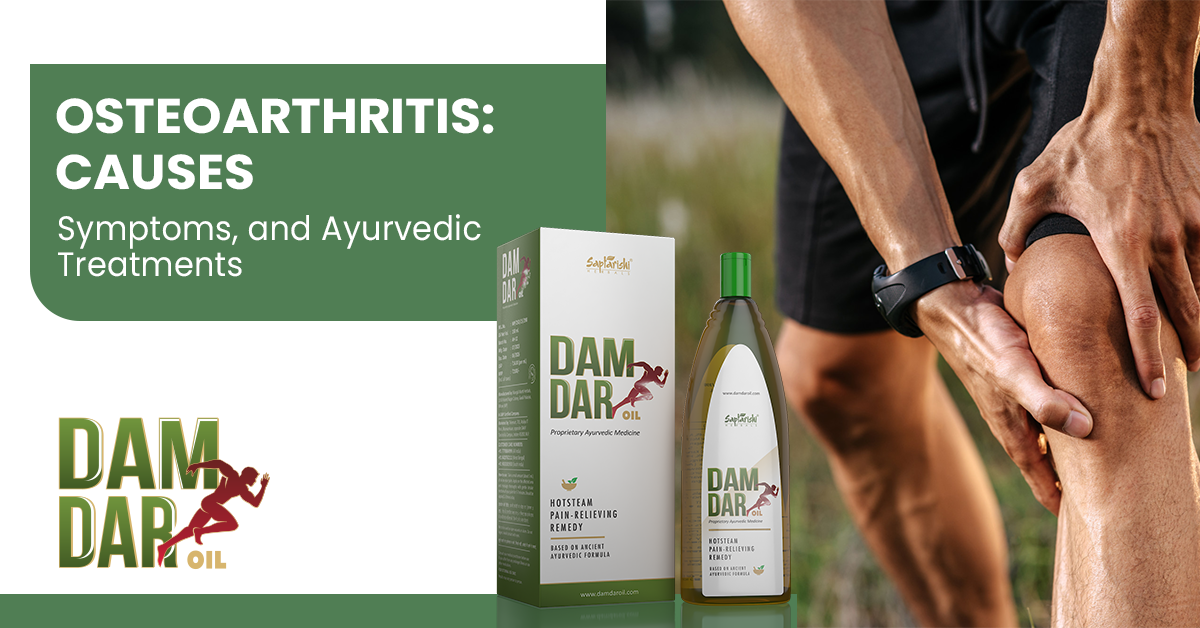Osteoarthritis: Causes, Symptoms, and Ayurvedic Treatments

Osteoarthritis is a painful joint condition that results from the loss of cartilage between the bones. The cartilage functions like the smooth cushions that prevent the bones from rubbing against each other. And when these cushions get damaged, there’s friction between the bones, causing inflammation and pain in the bones. While age is a common factor for this condition, it can occur due to other reasons, like injuries or lifestyle factors. In this blog, we will discuss the causes, symptoms, and ayurvedic treatments available that can help manage osteoarthritis naturally.
Causes and Risk Factors
Several reasons may lead to the development of osteoarthritis, such as:
Aging: The natural wear and tear over a long time damages the cartilages.
Joint injury: Past or present injuries could damage the joint.
Genetics: Joint conditions can be hereditary.
Overuse: Constant stress that can be sports-related or from certain jobs.
Obesity: Excess weight on joints can damage the tissues, causing joint inflammation.
Common Symptoms of Osteoarthritis
The common symptoms that can be symptoms of osteoarthritis are:
- Pain in the joints while walking or with movement
- Inflammation and tenderness
- Joint stiffness
- Hardness around the joint
Ayurvedic View of Sandhivata (Osteoarthritis)
Osteoarthritis is known as Sandhivata as per Ayurveda; Sandhi means joint, and Vata is the air element in the body. Ayurveda’s ancient principle attributes the disturbance in the air element in the body to the degeneration of joint tissues. It also causes dryness in the joints, pain and stiffness of the joints, cracking sounds, and restricted movement.
The diseases caused due to vata imbalance come under “Vata Vyadhi.”
Osteoarthritis Treatments: Modern vs Ayurvedic Treatments
Modern medicines are mostly preferred for their quick effectiveness, while Ayurveda manages the diseases by addressing the basic cause and provides root-level healing.
The modern approach includes the use of painkillers, steroids, physiotherapy, and joint replacement surgeries. However, long-term use of painkillers may lead to side effects. This is the reason why Ayurvedic joint care is gaining popularity, as natural remedies rarely have any side effects. Ayurvedic treatment aims at restoring dosha balance, promoting joint healing. Here’s how:
Herbal Remedies
Ayurveda uses time-tested herbs that are mentioned in the ancient scripture with pain-relieving and anti-inflammatory properties. Guggul, Shallaki, ashwagandha, Nirgundi, and Turmeric are a few of the herbs that are known to be highly beneficial for painful joint conditions.
Herbal Pain Relief Oils
Massaging with herbal pain relief oils like Damdar oil or Mahanarayan oil has several benefits.
-
Quick Relief from Pain and Swelling:
Herbal joint pain oils, like Damdar oil and Dhanwantara oil, are made with powerful herbs that go deep into the skin to reduce swelling and give fast relief from joint pain.
-
Better Movement and Flexibility:
Daily actions like bending, walking, and climbing stairs become easier and without pain while using this oil. They make your joints smooth and flexible, helping you move freely.
-
Heals and Nourishes:
Pain relief massage oils don’t just help in reducing pain, but they also nourish the skin and the deep joint tissues, helping them stay strong and healthy.
-
Helps You Relax:
Massaging with these oils feels good and helps you relax. It reduces stress, which is important when you’re dealing with long-term pain.
Medicated oil massage, or Abhyanga, is done to reduce stiffness and improve circulation. Using Damdar hotsteam joint pain relief oil for Swedana (herbal steam therapy) relieves joint pain and increases flexibility, and is most effective for osteoarthritis.
Ayurveda focuses on
- Balancing the doshas
- Nourishing the joint tissues
- Improving the blood circulation
- Detoxifying the body
Ayurvedic Diet
It is crucial to follow an anti-vata diet for osteoarthritis management. Avoid cold and raw foods and prefer warm, well-cooked foods. Herbal teas, soups, and stews are good for digestion as well as for restoring vata imbalance. Use good fats to lubricate the joints.
Include spices like ginger, fenugreek, and turmeric in your diet as they have anti-inflammatory properties.
Lifestyle Advice
- Be consistent with your daily routine. Yoga poses like Tadasana, Vajrasana, and Bhujangasana, stretching exercises, and walking are beneficial in improving and maintaining joint health.
- Avoid exposure to cold conditions, manage stress, and avoid overexertion.
- Ensure proper rest and hydration.
- Managing weight is highly recommended. Reducing a small amount of weight reduces pressure on joints, providing effective relief from joint pain.
Final Thoughts
Osteoarthritis though a common joint condition, but living with this pain significantly reduces the quality of one’s life. It can be effectively managed with modern as well as natural, Ayurvedic approach. Natural or herbal remedies, herbal massage oils like Damdar oil, Sandhi Sudha, or Maha Damdar oil, provide lasting results without any side effects. By making dietary and lifestyle changes, you can improve joint health and reduce pain naturally.
